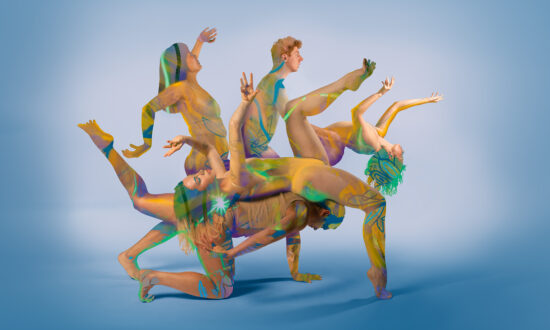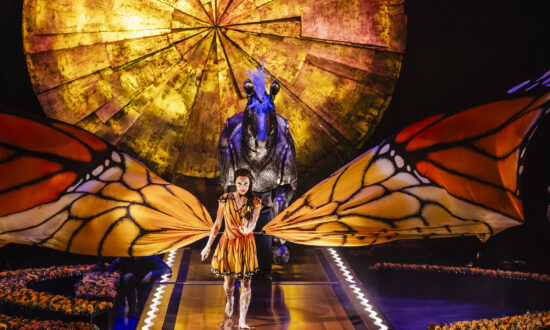The stage is stark, bathed in an otherworldly emerald glow from a narrow, rectangular digital strip hung high on the backdrop. The dancers appear, one by one, from stage left, to process in a slow, dignified pas marché across the stage accompanied by the opening strains of Act II from Adolphe Adam’s original 19th century score.
The electrifying green of their costumes deviates from the ballet blancs typical of this and other performances of the Romantic era, where female corps de ballet wore ethereal, calf-length white tulle, often to symbolise their otherworldliness. The colour green carries multiple symbolic meanings: the organic green of the forest, of burgeoning life, spring, and hope; the green that appears around the gills when sickness threatens. There’s the green of jealousy, too.
The letter ‘G’ appears in white on the green digital strip; then, the rest of the main protagonist’s name fades in, as if it were an afterthought. The dancers continue to flow across the stage, always from left to right, some of them now moving faster in a quick-footed, gliding pas de bourrée couru, and the musical tether to the original ballet is broken by the pulsing, industrial-distorted beats of Luke Smiles’ compulsive soundscape.
More solitary letters appear on screen, sometimes the anchor for a rush of impressionistic words that fade in to the blank spaces; Grief, lanGuage, entanglement, Glorification, Grand Jetée. The letters, instead of names, depersonalise the protagonists, as if they were factors in an algebraic formula. A, for Albrecht, Duke of Silesia and H, for Hilarion the gamekeeper, both of whom are in love with Giselle, though Albrecht betrays her, causing her to die of heartbreak; B, for Bathilde, the princess betrothed to the duplicitous Albrecht, and for Berthe, Giselle’s mother. M for Myrtha, Queen of the Wilis; she and her subjects the ghosts of young women who were jilted at the altar by the men they were betrothed to and die of heartbreak, and by, and who dwell in the forests intent on vengeance, using their beauty to lure men in a dance to the death.
The complex plot of the original ballet of Giselle requires an involved narrative, with dancers miming out each scene, but Stewart subverts this, too. There are visual references to the plot, like the bunch of white lilies Albrecht lays on Giselle’s grave, or his sword, which he hid in order to disguise the fact that he was a nobleman in order to seduce Giselle, and with which some versions of the ballet have Giselle kill herself after she goes mad with grief; there’s the blue and orange dawn at the lake where the Wilis drown Hilarion after making him dance to exhaustion.
The digital screen sometimes adds sentences to indicate the plot’s progress: G has a weak heart. G is now a wraith. G forgives. But the plot’s details, somewhat overwrought in the conventional form of the ballet in a way that borders on the mawkish, seem less important here. What matters are the raw, universally human emotions behind them, embodied in each dancer and in Stewart’s idiosyncratic choreographic style, which meshes the traditional and the subversive; dancers might set out on a step with a familiar movement from the classical ballet repertoire, only to convulse halfway through with a grotesque twist that conveys a sense of conventional expectations ripped away to expose the raw humanity, the human bodies, beneath.
G demands every ounce of the dancers’ athleticism and courage; a grand jetée flips into a tumble; a male dancer is dragged across the floor by his female counterpart, who wears his legs around her waist like a belt in a strange pas de deux. All the while, the dancers continue to flow across the stage, left to right, in relentless motion, sometimes in opposition to the text on the screen above, which sometimes rolls from right to left.
The dancers are not assigned separate roles, but share them: the women are all, in turns, Giselle, Bathilde, Berthe or Myrtha; the men all Albrecht or Hilarion. The effect is a paring away of the specificity of the Giselle narrative, exposing the full range of emotion expressed by all the characters, taking the story away from a singular time or location and elevating it to the universal.
Gender roles are subverted, too: the men tremble in the chorea of hysteria just as much as the women do, or entwine in loving embraces, and wear the same green as the women, a change from G’s 2008 debut performance, where the men wore suits of white. The impression is of a shared humanity, regardless of gender, class or role.

Get InReview in your inbox – free each Saturday. Local arts and culture – covered.
Thanks for signing up to the InReview newsletter.
G premiered in 2008 during the Adelaide Festival, then set out to tour Europe later the same year. It returned to tour the rest of Australia in 2013, after which it remained fallow until now.
Filtered through the awareness of new social movements such as #metoo, and the hardships of the pandemic, G offers the heart of the Giselle narrative in all its rawness to audiences in Adelaide, where it was created, as daring as it was 13 years ago.
After 22 years dedicated to pushing the boundaries of contemporary dance with ADT, it’s a fitting finale for Garry Stewart’s artistic directorship, and for the extraordinary Kimball Wong, who danced in the original 2008 performance along with Daniel Jaber, and who also departs the company this year.
ADT’s G will be presented at Her Majesty’s Theatre until November 29.
Support local arts journalism
Your support will help us continue the important work of InReview in publishing free professional journalism that celebrates, interrogates and amplifies arts and culture in South Australia.
Donate Here



